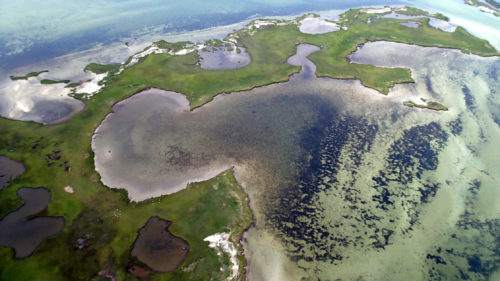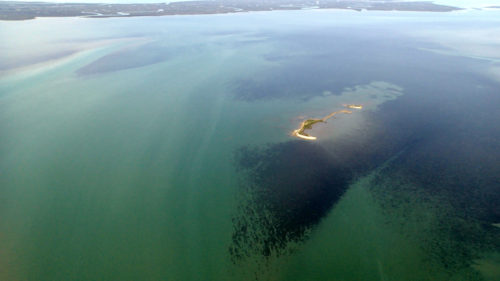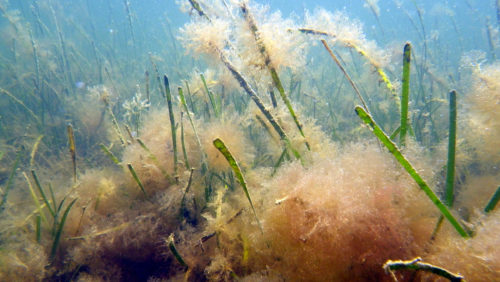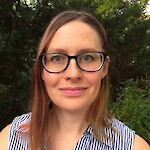UMCES Researchers Win Coveted Cozzarelli Prize for SAV Research in Chesapeake Bay
Katie May Laumann ·
The Cozzarelli Prize, a prestigious award recognizing excellence in scientific research, was awarded to UMCES very own Bill Dennison, Rebecca Murphy, and Jeremy Testa, lead author Jon Lefcheck (Smithsonian Environmental Research Center), and their co-authors (listed below) for their study of human impacts on underwater grasses in the Chesapeake Bay. The prize recognizes 6 papers, selected by the editorial board of the Proceedings of the National Academy of Sciences, each year. This study, entitled “Long-term nutrient reductions lead to the unprecedented recovery of a temperate coastal zone”, was among over 3,000 papers eligible for the 2018 award. Lefcheck et al. received the prize in the category of Applied Biological, Agricultural, and Environmental Sciences. Two of the authors, Drs. Jonathan S. Lefcheck and Robert J. Orth, traveled to Washington DC to accept the award on behalf of all of their co-authors. In addition to receiving the award from Dr. Alan Hastings of the PNAS Editorial Board during an Editorial Board Meeting, they were honored at the 156th Annual National Academy of Sciences Award Ceremony.

The complete list of authors is: Jonathan S. Lefcheck, Robert J. Orth, William C. Dennison, David J. Wilcox, Rebecca R. Murphy, Jennifer Keisman, Cassie Gurbisz, Michael Hannam, J. Brooke Landry, Kenneth A. Moore, Christopher J. Patrick, Jeremy Testa, Donald E. Weller, and Richard A. Batiuk.
For the award-winning study, the authors used over 30 years of data to study human impacts on Submerged Aquatic Vegetation (SAV) in the Chesapeake Bay. SAV are underwater plants that are extremely important both to natural communities and to people. They provide important habitat for many commercially important species, prevent shoreline erosion, and mitigate climate change by absorbing carbon; in fact, SAV beds worldwide store twice as much carbon as forests.

Photo by Jonathan S. Lefcheck
SAV have historically thrived in the Chesapeake Bay, and were abundant when the first European settlers arrived. Since the 1960’s, though, over half of the SAV in the Bay has been lost. SAV have been recognized as a “barometer of Chesapeake Bay Health”, with their losses signaling poor overall health in the Bay. The dramatic declines of SAV through the 1970’s led to collaborative SAV restoration and monitoring efforts. Among these efforts was an aerial monitoring program led by author Robert J. Orth.

Photo by Jonathan S. Lefcheck
These data were included in the study, which showed that nutrient pollution from agricultural fertilizer is the strongest contributor to SAV declines. Runoff of these fertilizers, as well as manure, leads to excessive levels of nutrients in Bay waters. Urban development also contributes, in part because development leads to higher levels of runoff. Rather than focusing on the negative, our authors showed that management efforts aimed at reducing nutrient pollution in the Bay have led to highly successful recovery of SAV. Over the last 34 years, the amount of the nutrient nitrogen has dropped by 23% in the Chesapeake Bay, AND 17,000 hectares (over 30,000 football fields) of SAV have been recovered. By definitively illustrating triggers for SAV decline and recovery, this study offers hope and a path forward for future SAV restoration efforts around the world.

Photo by Jonathan S. Lefcheck
The paper, “Long-term nutrient reductions lead to the unprecedented recovery of a temperate coastal zone”, can be found here: https://www.pnas.org/content/115/14/3658
Commentary on the importance of the study is published here: https://www.pnas.org/content/115/14/3518

Photo by Jonathan S. Lefcheck
Need more information on how nutrient pollution harms SAV?
Some levels of nutrients in the water are natural, and in the right amount, nutrients are important resources for SAV and other marine species. The problem occurs when the amount of nutrients in the water are unnaturally high. Algae in the water take up excess nutrients and “bloom”, reproducing rapidly and blocking sunlight from reaching SAV. Adding to this, increased nutrient levels lead to the overgrowth of other algae directly on SAV, preventing them from absorbing the light they need to thrive.
About the author
Katie May Laumann

Katie May earned a PhD in Marine Science (Virginia Institute of Marine Science) and an MA in Conservation Biology (Columbia University). Her research experience includes sturgeon phylogenetics and seafood sustainability. Before IAN, Katie May worked as a science outreach educator in Maine. She has also worked in fisheries management, sustainability certification, and grant writing. Katie May enjoys traveling and hiking. Her favorite hiking experiences include summiting Huayna Picchu in Peru and watching the sunrise from Mount Fuji. She lives in Shady Side with her husband and Berlioz, the best cat in the world.

